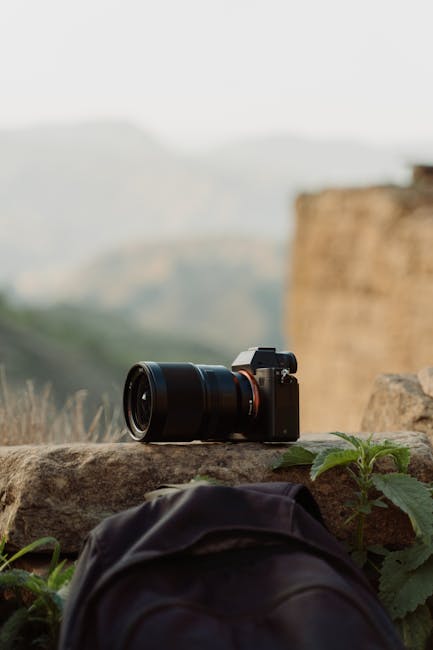How to Photograph Landscapes in Different Seasons with an SLR Digital Camera
Landscape photography offers a unique opportunity to capture the beauty of nature in its various forms. Each season presents its own set of challenges and opportunities for photographers. In this blog post, we’ll explore the nuances of photographing landscapes across different seasons using your SLR digital camera. Whether you’re a budding photographer or a seasoned veteran, these tips and techniques will help you enhance your landscape photography skills.
Understanding Seasonal Changes in Landscape Photography
Each season brings distinct changes in the environment, affecting light, color, and composition. Understanding these differences is crucial for capturing stunning landscape images. Let’s dive into the specifics of each season.
Spring: Capturing Renewal and Vibrancy
Spring is a season of renewal, characterized by blooming flowers, lush greenery, and vibrant colors. To capture the essence of spring:
- Focus on Macro Shots: Use a macro lens to photograph close-up details of blossoms and new growth. This can add a refreshing perspective to your landscape photography.
- Play with Light: Spring often has soft, diffused light, especially in the early morning and late afternoon. Use this to your advantage to highlight the vibrant colors.
- Incorporate Water Elements: Spring showers can create interesting reflections and add depth to your photos. Experiment with capturing reflections in ponds or puddles.
Summer: Embracing the Golden Hour
Summer landscapes are defined by bright sunlight, longer days, and lush vegetation. To take advantage of summer’s beauty:
- Shoot During the Golden Hour: The period just after sunrise and before sunset offers warm, golden light that can add a magical quality to your photos.
- Explore Coastal Landscapes: Beaches and coastal areas are particularly stunning in the summer. Use a polarizing filter to enhance the colors of the sky and water.
- Capture Night Skies: With clear summer skies, it’s a great time to experiment with night photography. Use a tripod and a slow shutter speed to capture star trails or the Milky Way.
Autumn: Showcasing the Warm Tones
Autumn is renowned for its warm tones, with leaves turning shades of red, orange, and yellow. To capture the beauty of autumn:
- Highlight Contrasts: Use the contrast between the warm colors of the leaves and the cooler colors of the sky or water to create striking images.
- Take Advantage of Fog: Autumn mornings often bring fog, which can add a mystical quality to your photos. Experiment with shooting in foggy conditions to create dramatic images.
- Focus on Forests and Trails: Forested areas are particularly beautiful in the fall. Capture the canopy of colorful leaves or explore paths covered in fallen leaves.
Winter: Embracing the Minimalism
Winter landscapes can be challenging due to the harsh conditions but offer unique opportunities for minimalist compositions. To photograph winter’s stark beauty:
- Utilize High Contrast: Snow-covered landscapes provide high contrast scenes. Use this to create dramatic black and white photos.
- Focus on Details: Frost, icicles, and snow patterns can serve as intriguing subjects. Use a macro lens to capture these details.
- Experiment with Reflections: Frozen lakes and ponds can create beautiful reflections. Incorporate these into your compositions for added interest.
Technical Tips for Landscape Photography with an SLR Digital Camera
Regardless of the season, certain technical considerations will help you improve your landscape photography.
Use the Right Equipment
Having the appropriate gear is essential for capturing stunning landscapes:
- Tripod: A sturdy tripod is crucial for stabilizing your camera, especially in low-light conditions or when using slow shutter speeds.
- Filters: Consider using polarizing filters to reduce glare and enhance colors, and ND filters to manage exposure in bright conditions.
- Wide-Angle Lens: A wide-angle lens is ideal for capturing expansive landscapes and adding depth to your images.
Master Exposure Settings
Achieving the right exposure is key to capturing the essence of a landscape:
- Aperture: Use a small aperture (high f-stop number) to ensure a large depth of field, keeping the entire scene in focus.
- Shutter Speed: Adjust your shutter speed based on lighting conditions and the effect you wish to achieve, such as freezing motion or capturing movement.
- ISO: Keep the ISO as low as possible to reduce noise, especially in bright conditions.
Consider Composition Techniques
Composition is vital for creating visually appealing images:
- Rule of Thirds: Use the rule of thirds to place points of interest along the grid lines for a balanced composition.
- Leading Lines: Incorporate natural lines, such as rivers or paths, to guide the viewer’s eye through the image.
- Foreground Interest: Include interesting elements in the foreground to add depth and dimension to your photos.
Post-Processing: Enhancing Your Landscape Photos
After capturing your images, post-processing can further enhance their quality:
- Adjust Exposure and Contrast: Use editing software to fine-tune the exposure and contrast, highlighting the details in your photo.
- Saturation and Vibrancy: Enhance the colors to make the landscape appear more vivid while maintaining a natural look.
- Sharpen and Reduce Noise: Apply sharpening tools to enhance details and reduce noise for a cleaner image.
Conclusion: Embrace the Beauty of Every Season
Photographing landscapes in different seasons with an SLR digital camera is a rewarding experience that allows you to capture the ever-changing beauty of nature. By understanding the unique characteristics of each season and applying the right techniques, you can create compelling and memorable landscape photographs. Remember, the key to successful landscape photography lies in preparation, practice, and a keen eye for detail. So grab your camera, head out into the great outdoors, and start capturing the stunning vistas around you.
To anybody wanting to take better photographs today: Click Here!

